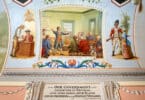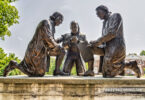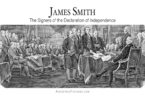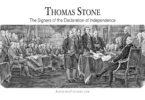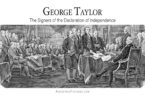George Clymer is another one of those signers of the Declaration of Independence who is not well-known by history, but who played an important part in it, at least in America. As a signer of the Declaration of Independence and an early American politician, George Clymer’s story is one that should be recovered by modern audiences and remembered by them. This is his story.
George Clymer was born in 1739 in Philadelphia and was orphaned by both parents at only one year old. As such, he was raised by his maternal aunt and uncle, whose names were Hannah and William Coleman. They raised him to become a merchant, giving him the education necessary to do it. After receiving his education, George married Elizabeth Meredith in 1765. Before the marriage, he wrote a letter to the minister of the church in which they intended to be married and admitted that he had previously fathered a child out of wedlock. The letter does not mention the name of the child or its mother.
After their marriage, George and Elizabeth had nine children together, five of whom survived past childhood. Their oldest surviving son was named Henry, and he married a Philadelphia socialite named Mary Willing. Other children of George and Elizabeth who survived past childhood were John, George, Ann, and Margaret. John, although he did live to reach adulthood, was killed in the 1787 Whiskey Rebellion at the age of 18.
George was a leader in the independence movement from the beginning and was active in it. He participated in demonstrations in Philadelphia against the Tea Act and the Stamp Act. He was appointed to the position of leader of the volunteer corps that belonged to the brigade of General John Cadwalader. In addition, George was accepted as a member of the American Philosophical Society in 1759, became a member of the Philadelphia Committee of Safety in 1773, and was appointed as a representative from Pennsylvania to the Continental Congress from 1776 to 1780.
While at the Continental Congress, George shared the office of Treasurer of that group with Michael Hillegas (Hillegas was later the first Treasurer of the United States). George served on several committees during his career at the Continental Congress and was even sent along with fellow appointee Sampson Mathews to inspect the northern army at Fort Ticonderoga in 1776.
When most of the Continental Congress temporarily fled Philadelphia when Sir Henry Clinton threatened to occupy the city, George stayed there with George Walton and Robert Morris. As part of the Continental Congress in 1776, George was a proud signer of the Declaration of Independence, as he had supported the cause of independence from the start.
Outside of the Continental Congress, George and his son John engaged together in a profitable trade with the island of St. Eustatius. Although he was trained for the merchant business, George was not that fond of it. Still, he continued increasing his fortunes quite well through it along with his father-in-law and brother-in-law until 1782.
After serving in the Continental Congress, George was elected to the Pennsylvania Legislature. The Legislature sent him on a tour of the new southern states in 1782 to try to get the legislatures of those states to pay their subscriptions that were due to the central government that had been designed by the Articles of Confederation. George continued to serve in the Legislature until 1787, when he was sent as a representative of his state to the Constitutional Convention, which was summoned together to change the wording of the Articles of Confederation (and, eventually produced an entirely new governing document for the United States—the Constitution). George continued his political career after this important appointment by being elected to the first official Congress of the United States in 1789.
Outside of his political career, George had a number of business and philanthropical ventures and interests. One of these was being the first president of the Philadelphia Bank, as well as of the Pennsylvania Academy of Fine Arts. He was also Vice-President of the Philadelphia Agricultural Society. He became head of the Excise Department in the state of Philadelphia after Congress passed a bill that put a duty on any spirits that were distilled in the new nation.
George was one of a group of commissioners who were sent to negotiate a treaty with the Creek Native American Tribe at Colerain, Georgia in 1796. Because of that role, he was in a position to be now considered as the benefactor of the Indian Borough, because he personally donated property for a county seat in Indiana County, Pennsylvania.
After a long and quite illustrious political career, George died in 1813 and was buried at the Friends Burying Ground in Trenton, New Jersey.
There are several honors that were given to George after he was gone, as part of his legacy in American history. The Navy ship, the USS George Clymer, was named after him. The town of Clymer in Indiana County, Pennsylvania, is also named for George, as is the town of Clymer, New York. A George Clymer Elementary School is in Philadelphia, which has largely educated children of color, to honor George’s advocacy for the civil rights of all people, regardless of race or color.
George’s home in Morrisville, Pennsylvania still stands and is known as Summerseat. Another house of his that is known as Ridgeland Mansion also still exists in the Fairmont Park part of Philadelphia. A street that goes alongside the Summerseat house in Morrisville is called Clymer Avenue.
There are still more honors for George Clymer to be found in modern America. There is a Clymer Street in Reading, Pennsylvania. Clymer Lane in the Leedom Estates area of Ridley Township, Pennsylvania is also there to remind the world of George Clymer’s existence in American history. Even as far away as Pentwater, Michigan, there is a Clymer Street that is named after him. George Clymer may not be well remembered as a signer of the Declaration of Independence, or even as a Founding Father, but his name is still stamped on American society, which ensures his legacy is secured.

